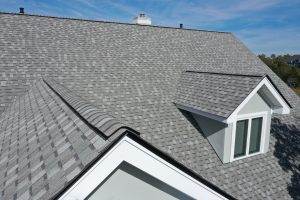6 Signs of Roof Damage

*Updated July 3rd, 2025
1. Missing or Damaged Shingles
Shingles are an integral part of your roof’s construction. When you notice some have gone missing, take action as soon as possible. Ignoring missing shingles can be a costly mistake, leading to rot, water intrusion, mold, or other serious issues that signal you may need a roof replacement.
A classic sign of roof damage caused by wind is missing, lifted, or creasing shingles. During a storm, high winds can result in entire shingles tearing off your roof and littering your yard. If your shingles already had cracks or were peeling, they are especially prone to storm damage.
In addition to wind, hail damage can result in cracks, dents, or holes in your roof and may be harder to spot from the ground. To spot roof damage caused by a recent storm, it’s worth investing in a professional roof inspection to assess whether your roof has storm damage and whether you need roof repair or a new roof.
2. Cracked or Curled Shingles
Over time, age and the elements can wear down your roofing material. Without proper protection, you may find asphalt shingles cracking or curling away from the surface. These are often silent signs of roof damage that allow water to seep in and cause extensive damage.
Poor installation techniques may also lead to damaged shingles. To help ensure you work with a trusted roofing contractor, we’ve put together a guide for questions to ask when hiring one. Depending on the severity, you might need to decide whether to repair or replace your roof entirely.
3. Granules in Gutters
Asphalt shingles have a protective layer of granules that shield your roof from UV rays and storm damage. But when you start finding those granules in your gutter, it may signal your roof is damaged.
Heavy hail and strong storms can strip away this layer, especially if your roof is aging. Finding granules in your downspouts or gutters is one of the more subtle but clear signs that your roof may need attention. If not addressed, this can reduce the overall life of your roof and eventually lead to a full roof replacement.
4. Sagging or Drooping Roof
A sagging or drooping roof is a major red flag. It often indicates structural damage, trapped moisture, or problems with the roof sheathing. These issues go beyond surface-level roof repair and may require a full roof replacement or repair, especially if there’s damage to the roof boards or interior water damage.
To prevent further damage, schedule a regular roof inspection and monitor for changes at the edge of your roof, in the roof valleys, and near any roof vent or chimney.
5. Water Stains or Leaks
Water damage isn’t always easy to spot. Even minor roof leaks can cause damage to the interior, including spots on the ceiling, bubbling paint, or warped drywall. These can all indicate a leak coming from your roof.
After a storm, grab a flashlight and head into the attic to look for signs of storm damage such as water stains, damp insulation, or rot. Any of these warning signs could point to a leaky roof or damaged flashing, and may mean you need a new roof.
Ignoring these common types of roof damage can compromise the integrity of your roof and even result in structural damage to your home.
6. Tree Limbs
If tree limbs or debris land on your roof during a storm, they can cause damage to your roof ranging from damaged shingles to deep structural problems. A heavy enough impact could damage the roofing material, the roof deck, or even your chimney or skylight.
Look for broken or missing shingles, dents, or punctures after a storm comes through. These are common signs that your roof needs attention. To help protect your home, regularly trim overhanging branches to minimize potential damage.
Even if no debris is visible, these incidents can cause hidden damage that only a roof inspection can uncover—essential for filing an accurate insurance claim if needed.
Final Thoughts
The silent signs outlined above are crucial to understanding whether you need to repair or replace your roof. Catching issues early—before they cause structural damage or interior water damage—can help extend the life of your roof.
Whether it’s hail damage, damaged flashing, or granules in your gutter, don’t wait to inspect your roof. If you’re unsure, call a professional roofing contractor to assess the situation. They’ll help you determine if you need a roof replacement, or if a roof repair can repair the damage and prevent further issues.
Get your roof checked after storms, stay on top of roof maintenance, and don’t ignore the tell-tale signs that your roof could be in trouble.
Additional Roofing Resources
- Do You Need a Drip Edge On Your Roof?
- Choosing the Best Roofing Material for Your Coastal Home
- The Ultimate Guide to Impact-Resistant Roofing Materials
- Tile Roofing: Advantages and Drawbacks

Anna has over six years of experience in the home services and journalism industries and serves as the Content Manager at MyHomePros.com, specializing in making complex home improvement topics like HVAC, roofing, and plumbing accessible to all. With a bachelor’s degree in journalism from Auburn University, she excels in crafting localized, comprehensive guides that cater to homeowners’ unique needs. Living on both coasts of the United States has equipped her with a distinctive perspective, fueling her passion for turning any house into a cherished home through informed, personalized decision-making.








